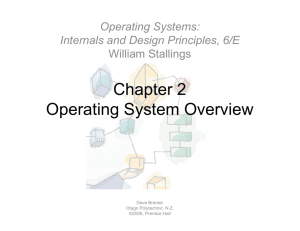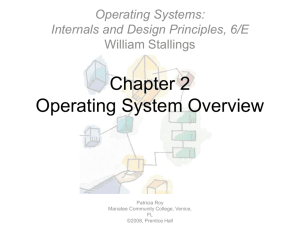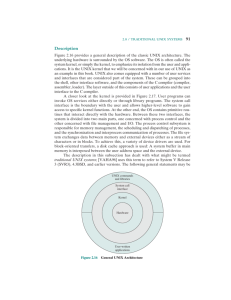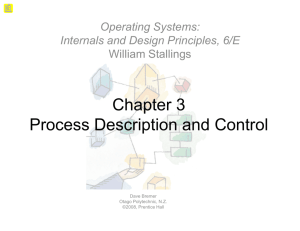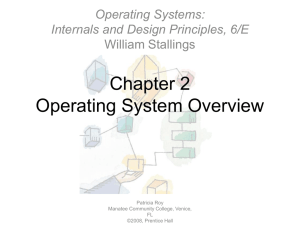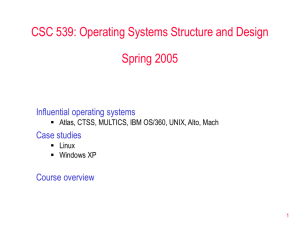Operating Systems
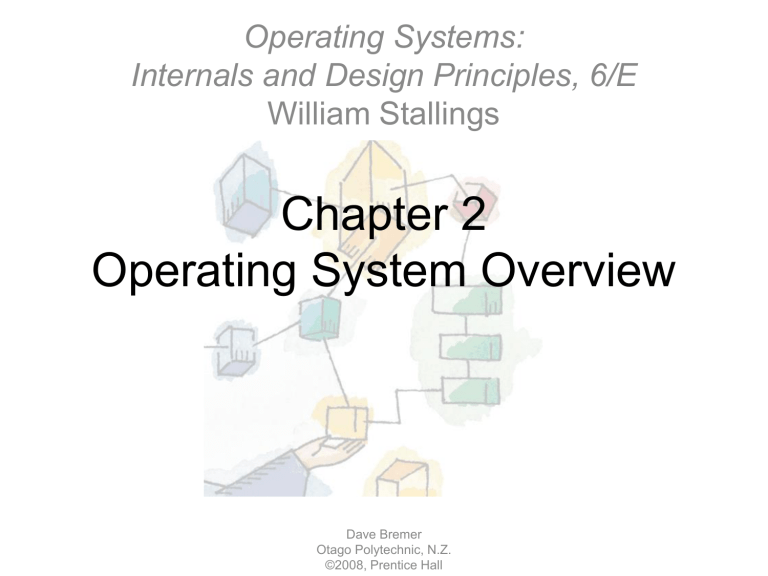
Operating Systems:
Internals and Design Principles, 6/E
William Stallings
Chapter 2
Operating System Overview
Dave Bremer
Otago Polytechnic, N.Z.
©2008, Prentice Hall
Admin
• Homework or lab problems?
– All HW & Labs via Bb
– Eqn 1.1
• Python is coming
– Python.org – tutorial (Documentation)
– 2.x rather than 3.x
Roadmap
– Operating System Objectives/Functions
– The Evolution of Operating Systems
– Major Achievements
– Developments Leading to Modern Operating
Systems
– Microsoft Windows Overview
– UNIX Systems
– Linux
Operating System
• A program that controls the execution of application programs
• An interface between applications and hardware
• Main objectives of an OS:
– Convenience
– Efficiency
– Ability to evolve
Layers and Views
Simple Structure
• MS-DOS – written to provide the most functionality in the least space
– Not divided into modules
– Interfaces and levels of functionality not well separated
Hardware
OS structure
• It’s not always clear how to stitch OS modules together:
Command Interpreter
Information Services
Error Handling
File System
Protection System
Accounting System
Process Management
Memory
Management
Secondary Storage
Management
I/O System
Services Provided by the Operating System
• Program development
– Editors and debuggers. (Apps)
• Program execution
– OS handles scheduling of numerous tasks required to execute a program
• Access I/O devices
– Each device will have unique interface
– OS presents standard interface to users
Services cont…
• Controlled access to files
– Accessing different media but presenting a common interface to users
– Provides protection in multi-access systems
• System access
– Controls access to the system and its resources
Services cont…
• Error detection and response
– Internal and external hardware errors
– Software errors
– Operating system cannot grant request of application
• Accounting
– Collect usage statistics
– Monitor performance
The Role of an OS
• A computer is a set of resources for the movement, storage, and processing of data.
• The OS is responsible for managing these resources.
Operating System as Software
• The OS functions in the same way as an ordinary computer software
– It is a program that is executed by the CPU
• Operating system relinquishes control of the processor
OS as
Resource Manager
Evolution of Operating
Systems
• Operating systems will evolve over time
– Hardware upgrades plus new types of hardware
– New services
– Fixes
Roadmap
– Operating System Objectives/Functions
– The Evolution of Operating Systems
– Major Achievements
– Developments Leading to Modern Operating
Systems
– Microsoft Windows Overview
– UNIX Systems
– Linux
Evolution of
Operating Systems
• It may be easier to understand the key requirements of an OS by considering the evolution of Operating Systems
• Stages include
– Serial Processing
– Simple Batch Systems
– Multiprogrammed batch systems
– Time Sharing Systems
Serial Processing
• No operating system
• Machines run from a console with display lights, toggle switches, input device, and printer
• Problems include:
– Scheduling
– Setup time
Serial processing today
• Modern microcontroller
– Functions are executed sequentially.
– Small code side
• hundreds to thousands of bytes
Simple batch system
• Early computers were extremely expensive
– Important to maximize processor utilization
• Monitor
– Software that controls the sequence of events
– Batch jobs together
– Program returns control to monitor when finished
Monitor’s perspective
• Monitor controls the sequence of events
• Resident Monitor is software always in memory
• Monitor reads in job and gives control
• Job returns control to monitor
Job Control Language
• Special type of programming language to control jobs
• Provides instruction to the monitor
– What compiler to use
– What data to use
Desirable Hardware
Features
• Memory protection for monitor
– Jobs cannot overwrite or alter
• Timer
– Prevent a job from monopolizing system
• Privileged instructions
– Only executed by the monitor
• Interrupts
Modes of Operation
• User Mode
– User program executes in user mode
– Certain areas of memory protected from user access
– Certain instructions may not be executed
• Kernel Mode
– Monitor executes in kernel mode
– Privileged instructions may be executed, all memory accessible.
Multiprogrammed
Batch Systems
• CPU is often idle
– Even with automatic job sequencing.
– I/O devices are slow compared to processor
Uniprogramming
• Processor must wait for I/O instruction to complete before preceding
Multiprogramming
• When one job needs to wait for I/O, the processor can switch to the other job
Multiprogramming
Example
Utilization Histograms
Time Sharing Systems
• Using multiprogramming to handle multiple interactive jobs
• Processor’s time is shared among multiple users
• Multiple users simultaneously access the system through terminals
Batch Multiprogramming vs. Time Sharing
Early Example: CTSS
• Compatible Time-Sharing System (CTSS)
– Developed at MIT as project MAC
• Time Slicing:
– When control was passed to a user
– User program and data loaded
– Clock generates interrupts about every 0.2 sec
– At each interrupt OS gained control and could assign processor to another user
CTSS Operation
Problems and Issues
• Multiple jobs in memory must be protected from each other’s data
• File system must be protected so that only authorised users can access
• Contention for resources must be handled
– Printers, storage etc
Roadmap
– Operating System Objectives/Functions
– The Evolution of Operating Systems
– Major Achievements
– Developments Leading to Modern Operating
Systems
– Microsoft Windows Overview
– UNIX Systems
– Linux
Major Advances
• Operating Systems are among the most complex pieces of software ever developed
• Major advances include:
– Processes
– Memory management
– Information protection and security
– Scheduling and resource management
– System
Process
• Fundamental to the structure of OS’s
• A process is:
– A program in execution
– An instance of a running program
– The entity that can be assigned to and executed on a processor
– A single sequential thread of execution, a current state, and an associated set of system resources.
Causes of Errors when
Designing System Software
• Error in designing an OS are often subtle and difficult to diagnose
• Errors typically include:
– Improper synchronization
– Failed mutual exclusion
– Non-determinate program operation
– Deadlocks
Components of a Process
• A process consists of
– An executable program
– Associated data needed by the program
– Execution context of the program (or “process state”)
• The execution context contains all information the operating system needs to manage the process
Process Management
Memory Management
• The OS has 5 principal storage management responsibilities
– Process isolation
– Automatic allocation and management
– Support of modular programming
– Protection and access control
– Long-term storage
Virtual Memory
• File system implements long-term store
• Virtual memory allows programs to address memory from a logical point of view
– Without regard to the limits of physical memory
Paging
• Allows process to be comprised of a number of fixed-size blocks, called pages
• Virtual address is a page number and an offset within the page
• Each page may be located any where in main memory
Virtual Memory
Virtual Memory
Addressing
Information Protection and Security
• The problem involves controlling access to computer systems and the information stored in them.
• Main issues are:
– Availability
– Confidentiality
– Data integrity
– Authenticity
Scheduling and
Resource Management
• Key responsibility of an OS is managing resources
• Resource allocation policies must consider:
– Fairness
– Differential responsiveness
– Efficiency
Key Elements of an
Operating System
System Structure
• View the system as a series of levels
• Each level performs a related subset of functions
• Each level relies on the next lower level to perform more primitive functions
• This decomposes a problem into a number of more manageable subproblems
OS Design Hierarchy
Roadmap
– Operating System Objectives/Functions
– The Evolution of Operating Systems
– Major Achievements
– Developments Leading to Modern
Operating Systems
– Microsoft Windows Overview
– UNIX Systems
– Linux
Different Architectural
Approaches
• Various approaches have been tried, categories include:
– Microkernel architecture
– Multithreading
– Symmetric multiprocessing
– Distributed operating systems
– Object-oriented design
Microkernel Architecture
• Most early OS are a monolithic kernel
– Most OS functionality resides in the kernel.
• A microkernel assigns only a few essential functions to the kernel
– Address spaces
– Interprocess communication (IPC)
– Basic scheduling
Multithreading
• Process is divided into threads that can run concurrently
• Thread
– Dispatchable unit of work
– executes sequentially and is interruptible
• Process is a collection of one or more threads
Symmetric multiprocessing (SMP)
• An SMP system has
– multiple processors
– These processors share same main memory and I/O facilities
– All processors can perform the same functions
• The OS of an SMP schedules processes or threads across all of the processors.
SMP Advantages
• Performance
– Allowing parallel processing
• Availability
– Failure of a single process does not halt the system
• Incremental Growth
– Additional processors can be added.
• Scaling
Multiprogramming and
Multiprocessing
Distributed
Operating Systems
• Provides the illusion of
– a single main memory space and
– single secondary memory space
• Early stage of development
Object-oriented design
• Used for adding modular extensions to a small kernel
• Enables programmers to customize an operating system without disrupting system integrity
Roadmap
– Operating System Objectives/Functions
– The Evolution of Operating Systems
– Major Achievements
– Developments Leading to Modern Operating
Systems
– Microsoft Windows Overview
– UNIX Systems
– Linux
Single-User
Multitasking
• From Windows 2000 on Windows development developed to exploit modern
32-bit and 64-bit microprocessors
• Designed for single users who run multiple programs
• Main drivers are:
– Increased memory and speed of microprocessors
– Support for virtual memory
Windows Architecture
Client/Server Model
• Windows OS, protected subsystem, and applications all use a client/server model
– Common in distributed systems, but can be used internal to a single system
• Processes communicate via RPC
Windows Objects
• Windows draws heavily on the concepts of object-oriented design.
• Key Object Oriented concepts used by
Windows are:
– Encapsulation
– Object class and instance
Roadmap
– Operating System Objectives/Functions
– The Evolution of Operating Systems
– Major Achievements
– Developments Leading to Modern Operating
Systems
– Microsoft Windows Overview
– UNIX Systems
– Linux
Description of UNIX
Traditional UNIX Kernel
System V Release 4
(SVR4)
Roadmap
– Operating System Objectives/Functions
– The Evolution of Operating Systems
– Major Achievements
– Developments Leading to Modern Operating
Systems
– Microsoft Windows Overview
– UNIX Systems
– Linux
Modular
Monolithic Kernel
• Although monolithic, the kernel is structures as a collection of modules
– Loadable modules
– An object file which can be linked and unlinked at run time
• Characteristics:
– Dynamic Linking
– Stackable modules
Linux Kernel Modules
Linux Kernel
Components
